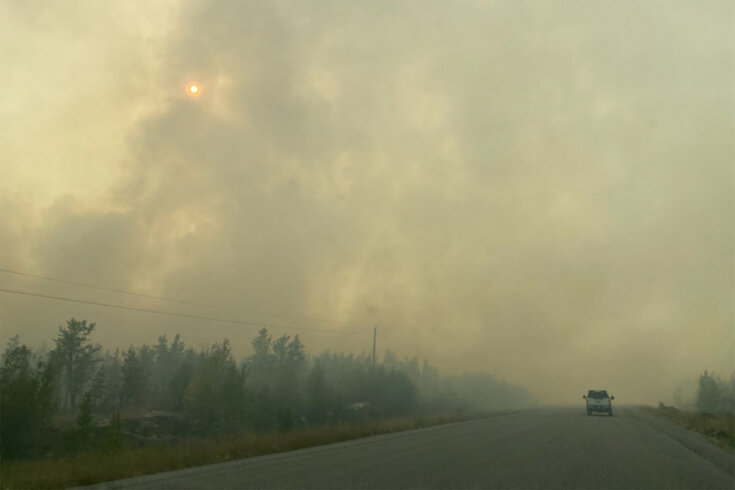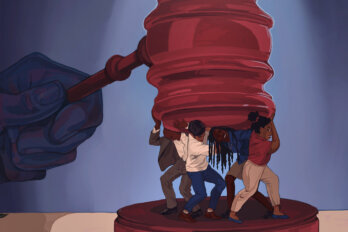In the days leading up to the Yellowknife wildfire evacuation order, I found myself in a familiar place: struggling to discern how much danger we were all in.
Even as a major blaze loomed twenty kilometres from the city’s outskirts, near our only road out, and two other fires closed in from the north and east, I was never sure if I was taking the threat seriously enough or if I was overreacting.
We’ve all been waging similar internal battles over the past three-plus years of public safety and social etiquette protocols introduced by the COVID-19 pandemic. Do I drop my kid off at daycare with that runny nose? Should I go to that party if I still have this sore throat? This constant and cumulative risk assessment—perceived or real, to myself or to others—seems to have damaged my ability to evaluate a threat and respond appropriately. My calculator is fried from overuse.
Wildfires are a part of Northern life. In 1998, a nearby fire blanketed the territorial capital in thick smoke. That summer’s edition of Folk on the Rocks, the local music festival, was known as Smoke on the Rocks. As a badge of pride, Yellowknifers swap stories about where they were one late-July day in 2014 when the skies went pitch black and rained ash around 5 p.m.
This fire season has felt different. The abnormally early start to summer. The prolonged and extremely hot and dry weather. Most major communities in the Northwest Territories have had disaster on their doorsteps, with evacuations of the town of Hay River and the Kátł’odeeche First Nation on the south side of Great Slave Lake in May, and of Behchokǫ̀—a Tłı̨chǫ Dene community of nearly 2,000, roughly one hour’s drive northwest of Yellowknife on the north side of the lake—in July.
By early August, ZF015, the fire that prompted Behchokǫ̀’s evacuation, began to shift our way. Officials told us there was no threat to the city and its 20,000 residents. I stayed glued to local media reports and refreshed a growing resource of smoke maps, fire updates, and satellite hotspot websites but carried on as usual.
Then, on Sunday, August 13, a fire south of the lake, swept along by westerly winds, covered almost forty kilometres in one day. Enterprise, a hamlet near the northern border of Alberta, was engulfed. Hay River and Kátł’odeeche First Nation residents were evacuated for the second time in three months. They were joined by Fort Smith residents, who had only just arrived in Hay River to seek refuge from their own mega fire, on a harrowing drive to escape the blaze and find safety in Alberta.
Up in Yellowknife, we followed the news nervously, yet many of us went to work that smoky Monday morning. I sent emails to set up meetings with people in towns that I knew had been abandoned. I rushed through dinner to make it to a fastball game, which we played through a thick haze. In retrospect, it felt like sleepwalking. Life went on. The next day, walking home at lunch, I passed a neighbour focused on a woodworking project in his backyard. Downtown, a mom wiped melted ice cream off her daughter’s hand with a napkin.
Still, the fire kept crawling closer. There were reminders everywhere. Like the reassuring drone of water bombers—audible for some time before they appeared, first as silhouettes, out of the haze. The rustling of drying, dying leaves on the birch tree next door made me shudder—it sounded like sizzling fire.
At that point, my sense of danger was starting to change. Maybe it was the stream of witness accounts in the media from Hay River evacuees fleeing in melting cars. Or photos emerging of Enterprise in ashes. Or how that fire had caught so many off guard. Or maybe Maui was still fresh on my mind.
By Tuesday night, residents in Yellowknife’s west end were put on evacuation alert and told to shelter at a local multiplex should the alert became an order. Anxious Yellowknifers wanted to know what would happen next. What would trigger a full-scale evacuation? There were no concrete answers, and frustrated and frightened residents vented on social media.
The thought of leaving town finally crossed my mind. The highway was still open. In news reports, officials said the fire wasn’t expected to arrive until the weekend—I was struck by the “when,” not “if,” of this statement. I started to take cues from what other people were doing. Some families were already driving out. I sent texts and made calls to friends and family to discuss plans, backup plans, and further contingencies. Friends gassed up their boats and put them in the water in case the highway closed and we needed to escape via the lake.
The local hospital was reducing services, including limiting the operating room to urgent cases, and I tried to convince a family member with respiratory issues to leave as soon as possible, reasoning that the smoke could cause her to become a drain on resources. The thought of leaving hadn’t even crossed her mind. I became curt, insistent, and kind of an asshole. Was I being overbearing? Or acting responsibly? I had no idea.
On Wednesday, another pandemic flashback: word of closures and service interruptions—seemingly unrelated—started to domino. Businesses were shutting down. A few hours after I dropped off my daughter, the daycare asked us to pick her up due to a sudden staff shortage. The writing was on the wall.
Now, my wife and I began to piece together a real plan. The family member I’d been short with was able to get on a flight. I apologized for my tone the night before as I hugged her goodbye at the airport, but she also thanked me for convincing her of the gravity of the situation.
Driving back into town, I wanted to yell out, “Do you have a plan!?!” to everyone I recognized along the road. Yet, even then, I was racked with doubt: Were we all just panicking needlessly? My year-end ball tournament still hadn’t been cancelled. I had a game scheduled for 6 p.m. that night.
My wife and I made the call to leave in the late afternoon after ensuring the people closest to us had plans to get out. Then we started to pack. But what to take? By this point, I was tapped out on decision making. I stuffed some running shoes into a backpack because, maybe, I’d go for a run wherever we ended up. We grabbed a couple changes of clothes, camping gear, and birth certificates while wondering whether we would be back in a few days or if this would be the last time we’d see our house.
We hit the road after 4 p.m., heading straight toward the towering smoke cloud that was causing this chaos. As we approached, a fleet of bombers buzzed it like mosquitoes. The smoke tower grew until it took up our whole frame of vision. Then we entered it. We crossed stretches of blazing fire along each side of the highway, but mostly it looked like random campfires had been set all around us. After about an hour and a half, we reached the turnoff to Behchokǫ̀ and a relatively safe section of highway to the next town. We breathed a sigh of relief, filling our lungs with this cleaner air.
I remain grateful for the privileges we had—a vehicle, flexible employers, a resilient two-year-old daughter and obliging thirteen-year-old cat—that allowed us to make the decision to leave a few hours before the official order to evacuate the city and surrounding areas, including the Dene communities of Ndılǫ and Dettah, was given around 7:30 p.m. As lifelong and long-time Yellowknifers, we also had a network of people to discuss the escalating risks with, unlike many newly arrived or vulnerable residents who may not have fully understood the events as they unfolded.
We drove through the night and arrived at my aunt and uncle’s house in St. Albert, outside Edmonton, at 8 a.m. I could smell the pancakes and bacon as I stepped out of our vehicle.
About a week later, with the fire continuing to rage not far from my hometown, I struggle with the gnawing guilt of leaving and whether I should have stayed to help. A small army of contractors, tradespeople, and skilled bushpeople has mobilized and is working eighteen-hour days with dedicated city and fire crews and the military to build a massive firebreak to protect our city. Air crews, nurses, the mayor, business owners, and so many other dedicated essential service providers and volunteers stuck around to ensure everyone could get out safely. Local media outlets, particularly Cabin Radio, also played a vital role, shutting down misinformation before it spread and questioning decisions by officials but also acting as conduits for information to help guide evacuation efforts. I’ve never taken more pride in my city, and with Yellowknife in such capable hands, I’m slowly able to accept that the best place for me is with my family.
I cling to a perhaps naïve hope that this evacuation was a precautionary measure. Government communications may have been imperfect and the execution clumsy, but even contemplating taking the step to get nearly 20,000 people to leave a city with just one highway out—a remote road with few refuelling stations, largely without cell service at the best of times, now surrounded by fire—was unprecedented. Despite some tense days, the call was made early enough that, as of this writing, more than 95 percent of Yellowknifers have made it out safely, meaning more than half of NWT residents are currently displaced.
Whenever any doubt creeps back and I start to question the danger we faced and our decision to leave, I return to our drive. On the southern side of Great Slave Lake, I took note of the odometer as we hit a particularly desolate burn area. It was a horizon of charred trees; the smoky earth was scorched black or ashen white. It went on. Every so often, a dozen or so spruce trees that hadn’t been torched flashed by. The splash of green was jarring, like colour suddenly appearing in a black and white movie.
Some thirty-five kilometres later, we arrived in Enterprise, and the devastation shocked us into silence. Winnie’s, a Dene arts-and-crafts store where I’d bought my wife some moccasins for Christmas when we first started dating, was completely gone. It felt awful realizing that Enterprise would be bearing such profound loss so publicly as thousands of people would drive by in the coming days.
For many kilometres south of the hamlet, it was the same smouldering landscape, with no signs of wildlife.
This was the last of the NWT I’ll see until I can return home.





